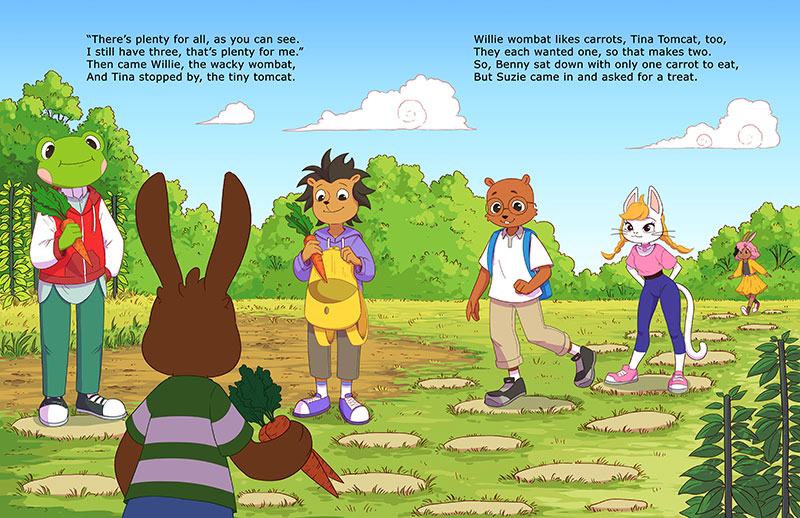Illustrated children’s books are a potent medium for captivating young minds, igniting creativity, and presenting engaging narratives. So that’s why publishers play an essential role in bringing these stories to the market, ensuring that illustrations complement the storytelling instead of dominating it. Grasping the criteria that publishers prioritize can assist authors and illustrators in crafting distinctive books. Let’s dig into the key aspects that can favor children’s book Illustrator in a good way:
Insights from Publishing Standards and Expectations
Publishers have selected expectations when choosing illustrated children’s books. They look for refined, market-ready content that captivates young readers and adheres to industry standards. Below are the essential factors they emphasize:
Strong Narrative & Cohesion – The narrative should possess a distinct beginning, middle, and end. The text and visuals must collaborate effectively to provide a fluid reading experience.
Age-Appropriate Themes – Publishers classify books according to age groups (for instance, board books for toddlers and picture books for early readers). The content must correspond with developmental milestones.
Unique Artistic Style – Originality is a must-have. Publishers prefer children’s book illustratorwith a distinctive style that enriches storytelling rather than replicating existing trends.
Emotional Resonance – Whether whimsical, humorous, or poignant, illustrations should elicit emotions that deepen the reader’s connection to the narrative.
Market Viability – Books must possess commercial attractiveness. Publishers consider genre popularity, cultural significance, and the potential for adaptation into multimedia formats.
Carefully understanding these criteria enables illustrators and authors to create books that are imaginative and commercially viable.
Visual Storytelling vs. Text Support: Striking the Right Balance
Illustrations are vital in enriching children’s literature, yet striking the right balance between images and text is imperative to maintain engagement. Publishers like those books that incorporate illustrations that support the narrative rather than overwhelm it.
The Importance of Illustrations
They animate characters, making the stories more captivating for young audiences. They assist children in grasping context, particularly for early learners who depend more on visuals than written words. They establish the mood, whether whimsical, serious, or educational.
Preventing Overcrowding
Certain amateur publications suffer from an overabundance of illustrations that clutter the pages and divert attention from the story. Publishers favor books where visuals enhance comprehension rather than compete with the text.
Employing Text Effectively
A minimal amount of text is most effective for picture books—illustrations should lead the narrative. The text should be succinct, reinforcing the visuals instead of reiterating what the images already convey.
Strategic text placement can contribute to a captivating reading experience, seamlessly complementing the illustrations. Successful children’s literature achieves this equilibrium, ensuring that both components collaborate to provide an immersive experience for young readers.
Common Pitfalls in Amateur Illustrations
Many aspiring illustrators face challenges in meeting professional standards due to frequent errors that can impede the marketability of their work. Below are several common pitfalls that publishers often observe:
–Inconsistent Character Design: Characters must maintain a uniform appearance throughout the book. Variations in proportions, facial expressions, or color schemes can disrupt continuity and diminish visual storytelling.
–Overcomplicated or Distracting Backgrounds: Although details can enhance an illustration, overcrowding backgrounds with too many elements can hinder young readers’ concentration on the main narrative. Clean, well-composed layouts are favored.
–Lack of Emotional Depth: Characters that express emotions are essential. Dull, expressionless faces make engaging children with the story challenging. Publishers seek artwork that vividly conveys joy, sadness, excitement, and other emotions.
–Poor Color Choices: Color schemes should align with the book’s tone. Jarring contrasts or mismatched colors can render illustrations look unprofessional. A skilled children’s book illustratorselects colors thoughtfully to enrich the storytelling.
– Ignoring Layout & Readability: Illustrations should integrate seamlessly within the book’s format. If text placement conflicts with images or becomes obscured by the background, it negatively impacts readability.
Well-organized layouts guarantee a smooth reading experience. By removing these pitfalls, illustrators can enhance their chances of publication and success in the competitive children’s book industry. If you are looking for professional art, hire a children’s book illustrator without a doubt.
How Does Deveo Studio Help Align Illustrations with Market Success?

Creating powerful illustrations necessitates a combination of skill, creativity, and knowledge of the industry. Deveo Studio is dedicated to assisting illustrators in perfecting their abilities to fulfill professional criteria and meet publisher demands.
Expert Illustrators: We provide best illustrators, who are adept in providing artistic expression and narrative techniques. Our professional knowledge of 400+ projects guarantees that the artwork aligns with contemporary publishing standards.
Customized Illustration Solutions: Whether it involves picture books, educational resources, or interactive media, Deveo Studio offers personalized illustration services to satisfy market requirements—we work closely with authors and publishers to produce refined, high-quality visuals.
Integration of Market Strategy: We recognize illustrations’ significant impact on book sales. Our team ensures that the artwork is visually appealing and suitable for the market, thereby increasing a book’s attractiveness to both publishers and consumers.
Improving Storytelling Through Visual Art: Besides technical illustration capabilities, we emphasize the importance of storytelling through visual art. We assist illustrators in crafting captivating visuals that enhance the narrative, making books more engaging for young audiences.
Way Forward
Creating an illustrated children’s book involves more than just artistic skill—it requires a comprehension of publishing norms, market demands, and the fundamentals of storytelling. Publishers are searching for books that feature compelling narratives, harmonious visuals, and commercial potential. Our motto governs the same.
Steering clear of novice errors and collaborating with industry professionals such as Deveo Studio can significantly enhance the likelihood of success. Whether you are an emerging author or children’s book illustrator, ensuring that your work meets professional standards will boost your book’s influence and market appeal.
By perfecting the craft of visual storytelling, achieving an appropriate equilibrium between text and illustrations, we produce books that engage publishers and enchant young readers. So, why wait? Contact us today and feel the creative process.







